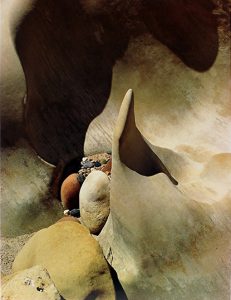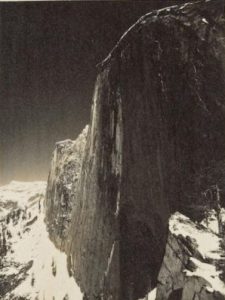
![]() Although this photograph did not appear in the Sierra Club book, In Wildness is the Preservation of the World, published in 1962, Porter chose to include it in a portfolio of ten dye transfer prints called In Wildness. The portfolio was produced in 1981 by Daniel Wolf Press, Inc., with prints made by the New York lab of Berkey K&L and approved by Porter. Of the seven prints that featured New England subjects, only three appeared in the original Sierra Club book, although one was a variant of a published image. Three other prints were subjects in Maine, while the remaining three featured photographs taken in Colorado, California, and Arizona.
Although this photograph did not appear in the Sierra Club book, In Wildness is the Preservation of the World, published in 1962, Porter chose to include it in a portfolio of ten dye transfer prints called In Wildness. The portfolio was produced in 1981 by Daniel Wolf Press, Inc., with prints made by the New York lab of Berkey K&L and approved by Porter. Of the seven prints that featured New England subjects, only three appeared in the original Sierra Club book, although one was a variant of a published image. Three other prints were subjects in Maine, while the remaining three featured photographs taken in Colorado, California, and Arizona.
While moving away from the New England imagery of the original Sierra Club book, Sculpted Rock, Marble Canyon, Arizona is typical of Porter’s preference for intimate views of the natural world. Closer in subject to his next Sierra Club project, The Place No One Knew: Glen Canyon on the Colorado, published in 1963, the photograph features rock formations in northern Arizona located near the beginning of the Grand Canyon. Named by John Wesley Powell on his second expedition to map the Colorado River in 1871-72, “marble” canyon is an inaccurate name for the polished limestone rock formations.

Marble Canyon was the site of the proposed Marble Canyon Dam in the 1950s. Vehemently opposed by the Sierra Club, the project was finally abandoned in 1968. Porter may have made this photograph the year before as a form of protest against the building of the dam, whose site was only about 100 miles downstream from Glen Canyon.
When compared to Ansel Adams’ Monolith, The Face of Half Dome, the difference between Porter’s and Adams’ styles is clear. While Adams presents the massive rock face as a grand “earth gesture,” to use his term, Porter invites us to examine intimate, human-scaled details in nature. Adams’ black and white image is a study in bold contrasts, while Porter’s delicately colored print emphasizes the soft colors and rounded shapes of the canyon rocks.